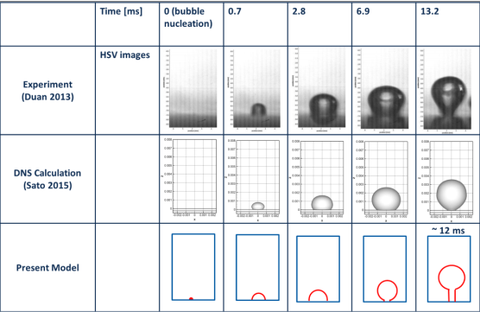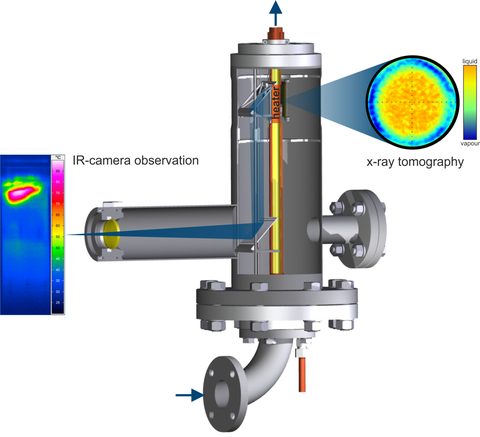CFD Method for the calculation of CHF - Subproject: development of the CFD model for the calculation of CHF with Euler/Euler approach
Motivation:
Boiling phenomena occur in technological applications where high heat fluxes have to be achieved, such as high-performance electronics and nuclear engineering. In nuclear engineering, the heat transfer in both reactor core and steam generator is of great interest regarding the safe operation of a nuclear power plant. Beyond a critical value of the heat flux (CHF), film boiling can occur. This so called boiling crisis and the departure from nucleate boiling must be avoided under all circumstances due to the imminent risk of damaging rod bundles in the reactor core. Efforts have been made to model this effect by means of computational fluid dynamics in the past. However, the applicability of the modelling techniques to boiling phenomena with varying technological configurations is currently limited.
Objectives:
In order to simulate the heat transfer in boiling processes with CFD methods the complex hydrodynamics of the fluid in the bundles of fuel rods with spacer must be considered and modelled. In the near future, stationary models still remain preferred for this large scale system due to too high computational resource requirements of the explicit transient calculations. However, the boiling process is not exactly macroscopically stationary when it reaches critical heat flux. It means that the first sub-objective should be finding a way to simulate the transient effects und critical heat flux condition in the stationary CFD calculations. The second sub-objective is to replace the conventional mostly empirical assumptions in the simulation by some new physical concepts.
Methods and results:
In this project, a new approach of the Euler-Euler two-phase modelling to calculate the bubble distribution and heat transfer will be developed to simulate the system near or even under boiling crisis. Based on the RPI heat flux partitioning model for subcooled boiling, the approach is extended by further model parts describing the boiling sublayer. In the bulk the GENTOP-concept developed at HZDR will be applied with the inhomogeneous MUSIG model in ANSYS CFX, to describe large gaseous structures. In order to validate the model and better understand the physical mechanisms of two-phase flow at boiling crisis, we will perform a series of experiments with a refrigerant-operated bundle facility and a steam/water experiment. This work will provide insight into the dynamic behavior of the bubble distribution in the core flow under different thermal hydraulic operating conditions in bundles of fuel rods.
With the help of activities of other project partners the transient process from nucleate boiling to film boiling will be understood more deeply. This deeper understanding should be the base to further develop the mechanistic CFD boiling model.

Fig. 1: Comparison between model predictions and experimental data for the process of steam bubble nucleation at a heater wall.

Fig. 2: Test section for studying boiling at critical heat flux. In the electrically heated pipe boiling up to boiling crisis is produced. An IR camera system measures the corresponding wall temperature distribution while the two-phase flow in the pipe is scanned with X-ray tomography.
Publications:
T. Geißler, 2015
On the influence of local flow structure on the boiling crisis
AMNT 2016, Hamburg, Deutschland
W. Ding, E. Krepper, U. Hampel, 2015
A Mechanistic model to predict the bubble departure in pool and forced convection boiling considering the sublayer
ISACC, Shenzhen, China
W. Ding, E. Krepper, U. Hampel, 2016
Prediction of the bubble departure in pool and forced convection boiling considering the sublayer: a sub model of CFD approaches
ICMF, Italia
